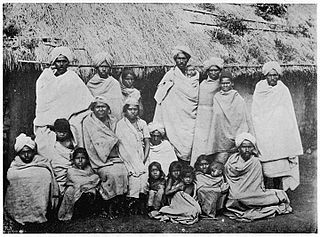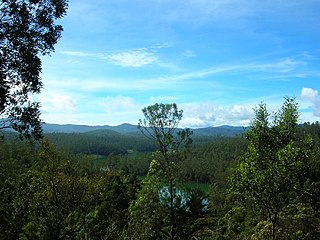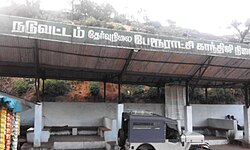
The Badagas are an ethno-linguistic community living in the Nilgiri district in Tamil Nadu, India. Throughout the district the Badugas live in nearly 400 villages, called Hattis.The Badagas speak a language called Badaga.
Miscegenation is a term which refers to reproduction by people who are considered to be members of different races. Anonymous authors invented the word in an 1863 fraudulent political pamphlet, indicating that miscegenation meant interracial marriage and interracial sexual relations, particularly between "... the American White Man and Negro". The term came to be associated with laws which banned interracial marriage and sex, these laws were known as anti-miscegenation laws.

The Nilgiris district is one of the 38 districts in the southern Indian state of Tamil Nadu. Nilgiri is the name given to a range of mountains spread across the borders among the states of Tamil Nadu, Karnataka and Kerala. The Nilgiri Hills are part of a larger mountain chain known as the Western Ghats. Their highest point is the mountain of Doddabetta, height 2,637 m. The district is contained mainly within the Nilgiri Mountains range. The administrative headquarters is located at Ooty. The district is bounded by Malappuram district of Kerala to the west, Coimbatore and Palakkad to the south, Erode to the east, and Chamarajnagar district of Karnataka and Wayanad district of Kerala to the north. As it is located at the junction of three states namely Tamil Nadu, Kerala, and Karnataka, a significant Malayali and Kannadiga population reside in the district.

The Madras Presidency, or the Presidency of Fort St. George, and also known as Madras Province, was an administrative subdivision (presidency) of British India. At its greatest extent, the presidency included most of southern India, including the whole of the Indian state of Andhra Pradesh, and parts of Tamil Nadu, Kerala, Karnataka, Telangana, Odisha and the union territory of Lakshadweep. The city of Madras was the winter capital of the Presidency and Ootacamund or Ooty, the summer capital. The Island of Ceylon was a part of Madras Presidency from 1793 to 1798 when it was created a Crown colony. Madras Presidency was neighboured by the Kingdom of Mysore on the northwest, Kingdom of Cochin on the southwest, and the Kingdom of Hyderabad on the north. Some parts of the presidency were also flanked by Bombay Presidency (Konkan) and Central Provinces and Berar.

Malabar District was an administrative district of Madras Presidency in British India and independent India's Madras State. It was the most populous and the third-largest district in the erstwhile Madras State. The British district included the present-day districts of Kannur, Kozhikode, Wayanad, Malappuram, Palakkad, Chavakad Taluk and parts of Kodungallur Taluk of Thrissur district, and Fort Kochi area of Ernakulam district in the northern and central parts of present Kerala state, the Lakshadweep Islands, and the Gudalur taluk and Pandalur taluk of Nilgiris district in Tamil Nadu. The detached settlements of Tangasseri and Anchuthengu, which were British colonies within the kingdom of Travancore in southern Kerala, also formed part of Malabar District. After the formation of Kerala state in 1956, present Kasaragod district also became a part of Malabar.
Interracial marriage is a form of marriage involving spouses who belong to different races or racialized ethnicities.

Kolam Thullal is a ritual dance form prevalent in south Kerala, southern India. It is customary in houses and temples of Bhagavathy, a female deity. It is performed at temple festivals and to drive away evil spirits from the "possessed" bodies. Its origins lie with the Tinta group of the Kaniyar caste. The ritual is similar to the Tovil and Kolam rituals of the Sinhalese people in Sri Lanka
Chinese people in India are separate communities with separate origins and settlement. There are permanent communities descended from immigrants and refugees from China and the other is an expatriate community in India on a temporary basis.

The Nilgiri Mountains form part of the Western Ghats in western Tamil Nadu, India. At least 24 of the Nilgiri Mountains' peaks are above 2,000 metres (6,600 ft), the highest peak being Doddabetta, at 2,637 metres (8,652 ft).
Chindian is an informal term used to refer to a person of mixed Indian and Chinese ancestry; i.e. from any of the host of ethnic groups native to modern China and India. There are a considerable number of Chindians in Malaysia, Singapore, and Myanmar. In Maritime Southeast Asia, people of Chinese and Indian origin immigrated in large numbers during the 19th and 20th centuries. There are also a sizeable number living in Hong Kong and smaller numbers in other countries with large overseas Chinese and Indian diaspora, such as Jamaica, Trinidad and Tobago, Suriname and Guyana in the Caribbean, as well as in Indonesia, the Philippines, the United States, Canada, United Kingdom, Australia, and New Zealand.

Kalasa is a taluk located in Chikkamagaluru district in Karnataka. Kalasa is home to the Kalaseshwara Temple dedicated to Lord Shiva. Kalasa lies 92 Kilometres South-west of Chickmagalur and is located on the banks of the Bhadra River.

Edgar ThurstonCIE was a superintendent at the Madras Government Museum who contributed to studies in the zoology, ethnology and botany of India and published works related to his work at the museum. Thurston was educated in medicine and lectured in anatomy at the Madras Medical College while also holding his position at the museum. His early works were on numismatics and geology and these were followed by researches in anthropology and ethnography. He succeeded Frederick S. Mullaly as the superintendent of ethnography for the Madras Presidency.
Valluvar வள்ளுவர் is a caste belonging to the Hindu community in the Indian state of Tamil Nadu. They are the hereditary priests preaching and practicing astrology, astromomy and medicine in Tamil Nadu.
Couvade is a term which was coined by anthropologist E. B. Tylor in 1865 to refer to certain rituals in several cultures that fathers adopt during pregnancy.
The Nai, Nais, Nao, Mhāli, Bhanāri, Mangala -The occupational caste of barbers. The name is said to be derived from the Sanskrit nāpita(नपित). They are found throughout the India. In Gujarat they are known as Valand. In Bundelkhand they are also known as Khawās. Nhavi is the Marathi name for the caste, Bhandāri the Uriya name and Mangala the Telugu name. Mhāllo.—A name for Konkani barbers. Vilkurup.—The Vilkuruppu or Vilkollakuruppu are the priests and barbers of the Malayālam Kammālans. Ambattan are the Tamil barbers, or barber-surgeons. Nowadays in northern India Nai community refer to themselves as Sain instead of Nai.In North India Nai use surname as Srivastava, Savita,Sain,Srivas.

Castes and Tribes of Southern India is a seven-volume encyclopedia of social groups of Madras Presidency and the princely states of Travancore, Mysore, Coorg and Pudukkottai published by British museologist Edgar Thurston and K. Rangachari in 1909.

Diwan Bahadur Kadambi Rangachari (1868–1934) was an Indian ethnologist who served as Assistant Superintendent of the Madras museum. He co-authored the 7-volume ethnographic encyclopedia Castes and Tribes of Southern India along with the British museologist Edgar Thurston. He was awarded the title Diwan Bahadur for his efforts.
The Kuravar is an ethnic Tamil community native to the Kurinji mountain region of Kerala, India.

The Nilgiri Malabar Battalion (NMB) was an Auxiliary Force (India) of the British Colonial Auxiliary Forces of the British Indian Army, composed of Eurasians/Anglo-Indians. Enrollment in the Auxiliary Force was open to all European British subjects and to persons of European descent. After the Mutiny of 1857, a Volunteer Force was created, whose primary function was to protect British families in India. The Volunteer Force units were later absorbed into the Auxiliary Force India, which was created in 1920 for internal security duties. Its terms of service were similar to the Territorial Army of the UK. The Auxiliary Force India, which provided officers to the Army during World War II, was disbanded in 1947.
The Panar are a community found mainly in Kundapura Taluk, Udupi District, Karnataka, India. The Panar are classified as Scheduled caste by the government of Karnataka.











